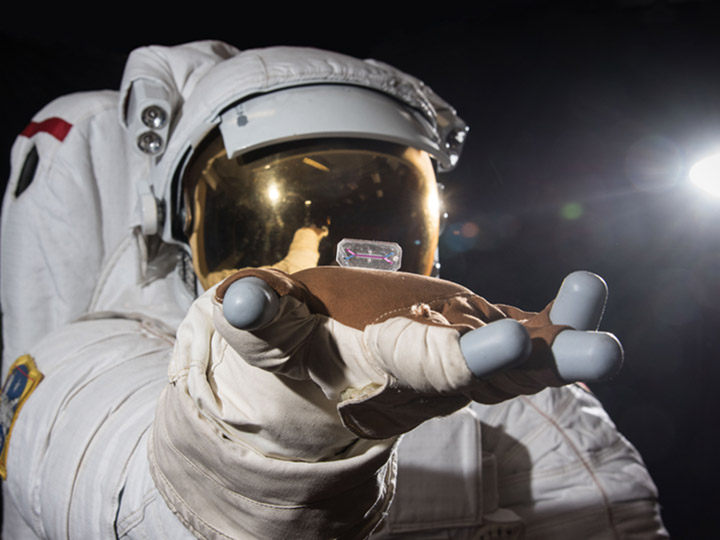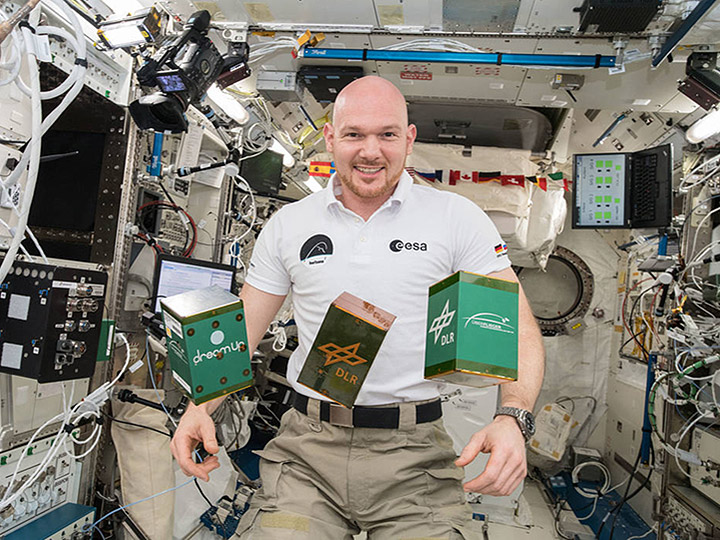Nicole Wagner is the president and CEO of LambdaVision, a startup company focused on developing an innovative protein-based retinal implant capable of restoring high-resolution vision and enhancing quality of life for patients with retinal degeneration. The implant technology uses a light-activated protein to stimulate the retina of patients with impaired vision due to age-related macular degeneration and retinitis pigmentosa.

Nicole Wagner, Ph.D., President and CEO of LambdaVision
Media Credit: Image courtesy of LambdaVision
LambdaVision is aiming to use the microgravity environment on the International Space Station (ISS) to improve the manufacturing process for their retinal implant. The company’s investigation, which recently launched on SpaceX’s 16th commercial resupply services mission, is supported by a “Technology in Space” prize—an award sponsored by the ISS National Lab and Boeing that supports startups associated with the MassChallenge program, one of the leading startup accelerators.
LambdaVision was founded in 2009 as a spinoff company from a University of Connecticut research group led by Robert R. Birge, distinguished professor of chemistry. Wagner worked in Birge’s research lab both prior to and during the establishment of LambdaVision.
We recently talked with Wagner about her thoughts on LambdaVision’s ISS National Lab investigation.
We’re driven to find solutions to challenging things. We’re laying the framework to develop future technologies and are paving the way. If you have the outlook that everything you do is having a small impact, it helps you get through to the big picture.
Working in microgravity gives us unique opportunities. Our process is all about having a homogeneous protein solution. In microgravity, we’re able to produce a more homogeneous solution and have the proteins adhere in a better way, using less materials and producing a better, higher-quality product.

LambdaVision President and CEO Nicole Wagner purifying the protein for use in the retinal implant.
Media Credit: Image courtesy of Peter Morenus/UConn Photo
We want the implant to last the lifetime of the individual receiving it. One of our goals is to increase the life span of the implant. We believe that producing the implant in microgravity will enable a more perfect surface and a better, more stable coating.
There is currently no cure for age-related macular degeneration and retinitis pigmentosa. There are only treatments that will slow the progression of disease. People with these diseases lose the ability to take light and convert that light into a signal that can be sent to the brain. In other words, their eyes become light insensitive. Our retinal implant helps the eye capture light again so that it can be used to generate a neural signal. The protein we use is light-activated and can generate an ion gradient, which will stimulate the remaining cells in the eye.
We’re taking more of an organic approach that’s very different to what’s available otherwise. Competing technologies are all more hardware-driven and often have big goggles or glasses supported by battery packs with wires and cables. They really are engineering marvels, but they are limited in resolution. Our approach provides better pixel density and better resolution for the patient.

LambdaVision’s tiny protein-based retinal implant. The implant is the small purple dot, which is about the size of a paper hole punch.
Media Credit: Image courtesy of Peter Morenus/UConn Photo
We want patients to be able to regain their independence. We want them to be able to make out the shapes of things, navigate a room, open doors, see small things on a computer. Imagine you’re about to become a grandparent and you come to a point where you can’t read your grandchild a book. Or imagine you’ve had to give up your career or the success you’ve built because you can no longer see the computer screen. That’s the kind of impact we can have on people’s lives by helping them regain their functional vision.
Science is not like the mad scientist stuff you see in cartoons. I always enjoyed science in high school, but you don’t always know what a scientist does. You know what nurses and doctors do because it’s more tangible. It wasn’t until I joined a research lab that I saw what scientists really work on. They’re real people working on real-world solutions to problems that can help people in an impactful way.
Our goal is not to be a one-and-done operation. If successful, we’d love to continue collaborating with our space partners. Our layer-by-layer approach has real potential for manufacturing a number of different technologies.
The protein we use comes from an organism called a “salt-marsh archaea.” We have to create an environment for it that’s like the Dead Sea. We create a super-saline environment to grow the protein and buy 100-pound boxes of salt in order to do it.

LambdaVision creates a super-saline environment to grow the protein. Shown is a series of shaker flasks containing the light-activated protein, bacteriorhodopsin, which will eventually be isolated and purified before being used in the retinal implant.
Media Credit: Image courtesy of Peter Morenus/UConn Photo
The whole experience for us has been incredible. Space Tango was instrumental in helping us miniaturize our device for use on the space station and automate our manufacturing process in a CubeLab. The entire process can be controlled from Earth, and we’re able to communicate if needed with the astronauts onboard the space station. Space Tango has a great team that is not afraid to take on tough challenges.
I never would have predicted any of this. It’s amazing how life takes you on a journey. When I started at the University of Connecticut, I was headed toward medical school. To think about owning a small business would have been crazy at the time. When I initially got involved in this work, it was only to check a box on a form for a research requirement. I wanted to go to medical school, become a doctor, and help people. But I fell in love with what we were doing. I could see the applications and where it could be used.

Wagner at Kennedy Space Center the day before the SpaceX CRS-16 launch.
Media Credit: Image courtesy of Nicole Wagner
Work-life balance gets harder when you have kids. My kids think it’s great to visit mommy’s work. My 3-year-old asks, “Are you going to the moon? Are you going on the rocket soon?”
Always be encouraged to try new things. Never be afraid of failing. Never be afraid to ask. There’s a lot of pivots along the way, and we’ve done a lot of cool things because of that.
The work we’re doing at LambdaVision is really important. The research we’re doing on the ISS is a way to potentially get our implant to patients faster. If this is successful, we’ll have a more homogeneous implant to make a positive impact on real people’s lives.






